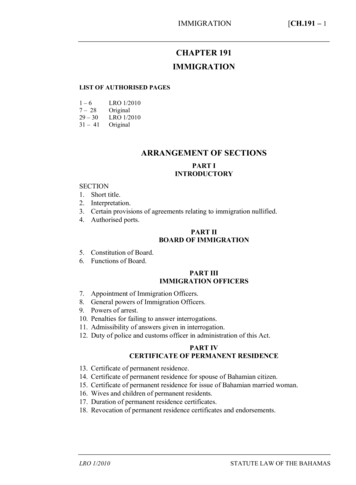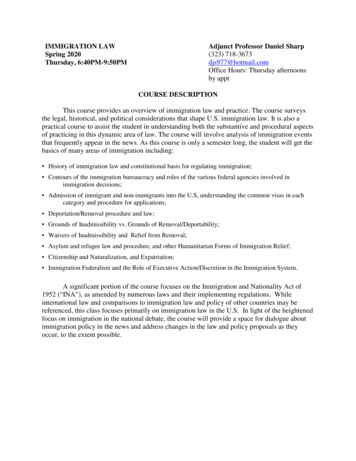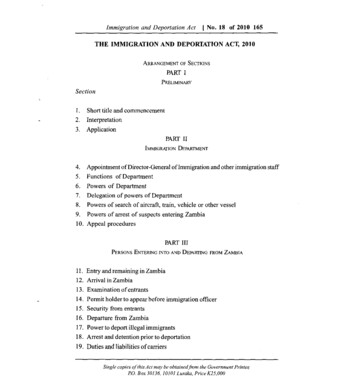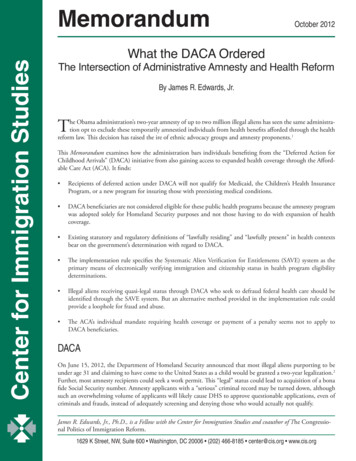
Transcription
Center for Immigration StudiesImmigration From MexicoAssessing the Impact on the United StatesBy Steven A. CamarotaJuly 2001ISBN 1-881290-49-2Center for Immigration Studies1522 K Street, N.W., Suite 820Washington, DC 20005-1202Phone (202) 466-8185FAX (202) 466-8076center@cis.orgwww.cis.org1
Center for Immigration StudiesAbout the AuthorSteven A. Camarota is Director of Research at the Center for Immigration Studies in Washington, D.C. He holds a master’s degree in political science from the University of Pennsylvania and a Ph.D. in public policy analysis from the University of Virginia. Dr. Camarota hastestified before Congress and has published widely on the political and economic effects ofimmigration on the United States. His articles on the impact of immigration have appearedin both academic publications and the popular press including Social Science Quarterly, TheWashington Post, The Chicago Tribune, Campaigns and Elections, and National Review. Hismost recent works published by the Center for Immigration Studies are: Without Coverage:Immigration’s Impact on the Size and Growth of the Population Lacking Health Insurance,Reconsidering Immigrant Entrepreneurship: An Examination of Self-Employment Among Natives and the Foreign-born, and Importing Poverty: Immigration’s Impact on the Size and Growthof the Poor Population in the United States.About the CenterThe Center for Immigration Studies, founded in 1985, is a non-profit, non-partisan researchorganization in Washington, D.C. which examines and critiques the impact of immigration onthe United States. It provides a variety of services for policymakers, journalists, and academics,including an e-mail news service, a Backgrounder series and other publications, congressionaltestimony, and public briefings.2
Center for Immigration StudiesTable of Contents5.Executive SummaryFindingsData SourcesPolicy RecommendationsImproving the Situation for Legal Mexican ImmigrantsReducing Future Unskilled Legal Mexican ImmigrationReducing Future Illegal Mexican ImmigrationGuestworker Programs Do Not Solve the ProblemConclusion11.Introduction11.Data Sources13.Numbers and Geographic DistributionA Rapidly Growing PopulationLower Fertility in Mexico Is Not Leading to a Reduction in ImmigrationMexican Immigration Is a Recent PhenomenonMexicans Are a Growing Share of the Foreign-BornA Highly Concentrated Population17.Labor Market Characteristics of Mexican Immigrants in the United StatesEducational Attainment of Mexican ImmigrantsMexican Immigration Has Dramatically Increased the Number ofDropoutsDistribution of Mexican Immigrants Across OccupationsIllegal Aliens from MexicoDistribution of Legal and Illegal Immigrants Across OccupationsDistribution of Mexican Immigrants Across IndustriesDistribution of Legal and Illegal immigrants Across Industries21.Impact of Mexican Immigration on Wages and Prices in the United StatesMost Natives Do Not Face Job Competition from Mexican ImmigrantsUnskilled Natives and Mexican Immigrants Hold Similar JobsPrevious Research Found That Immigration Harms Unskilled NativesImpact of Mexican Immigration on PricesMexican Immigrants Account for a Small Share of Economic Output27.Impact on Native-Born WorkersWorkers Harmed Are the Poorest and Most VulnerableWages for the Unskilled Declined in the 1990s3
Center for Immigration Studies29.Poverty and IncomeMexican Immigrants Have Very High Poverty RatesNear Poverty Also Common Among Mexican ImmigrantsPoverty and Near Poverty Over TimePoverty Among Legal and Illegal Mexican ImmigrantsMexican Immigrants Have Much Lower Average Incomes Than NativesIncome Among Legal and Illegal Mexican Immigrants35.Use of Means-Tested ProgramsMexican Use of Means-Tested Programs Remains High Even AfterWelfare ReformMexican Use of Means-Tested Programs Over TimeUse of Means-Tested Programs by Working MexicansUse of Means-Tested Programs by Legal and Illegal Immigrants43.Health Insurance CoverageLack of Health Insurance Common Among Mexican ImmigrantsLack of Health Insurance Remains a Problem Even for Long-TimeMexican ImmigrantsInsurance Coverage Among Legal and Illegal Mexican Immigrants47.Socio-Economic Status by Educational Attainment49.School-Age PopulationImpact on School-Age Population by State51.Characteristics of Mexican Immigrants by StatePoverty/Near Poverty by StateWelfare Use and Insurance Coverage by State53.Impact of Mexican Immigration on Public Coffers55.2nd- and 3rd-Generation Mexican-AmericansNative-Born Mexican-Americans Lag Far Behind Other Natives57.Conclusion and Policy RecommendationsImproving the Situation for Legal Mexican ImmigrantsReducing Future Unskilled Legal Mexican ImmigrationReducing Future Illegal Mexican ImmigrationGuestworker Programs Do Not Solve the ProblemArguments in Favor of Mexican ImmigrationFinal Thoughts62.End Notes4
Center for Immigration StudiesExecutive SummaryAt their summit in February of this year, the new Presidents of Mexico and the United Statespromised to work together to create an “orderly framework for migration” between their countries. As a result of the summit, a new high-level working group has been established to studymigration between the United States and Mexico. A number of members of Congress have alsoproposed changes in the laws governing immigration from Mexico, including a new guestworkerprogram for Mexicans, an increase in legal immigration from Mexico, and an amnesty for illegalaliens. Whatever the outcome of these initiatives, policymakers in the United States clearlyneed up-to-date information in order to weigh the costs and benefits of such programs. Usingthe latest data available, this report examines the characteristics of the Mexican-born population in the United States in order to shed light on the effect Mexican immigration has on thiscountry and to provide insight into the likely impact of future immigration from Mexico.The report comes to some very troubling conclusions. By increasing the supply ofunskilled labor, Mexican immigration has reduced the wages of workers who lack a high schooleducation. This reduction in wages for the unskilled (who are already among the poorest workers in the United States) may reduce prices in the United States by no more than one or twotenths of one percent. The effect is so small because unskilled workers account for only a tinyshare of economic output. Thus, even a substantial reduction in their wages cannot generatelarge benefits for consumers. Moreover, because such a large share of Mexicans are unskilled ata time when the U.S. economy offers limited opportunities to unskilled workers, Mexicanimmigration has added significantly to the size of the poor and uninsured populations, and tothe nation’s welfare case load. Their much lower incomes and resulting lower tax contributioncoupled with heavy use of means-tested programs creates very significant fiscal costs for thecountry. In effect, Mexican immigration acts as a subsidy to businesses that employ unskilledworkers — holding down labor costs — while taxpayers pick up the costs of providing servicesto a much larger poor and low-income population.FindingslLarge-scale immigration from Mexico is a very recent phenomenon. In 1970, the Mexicanimmigrant population was less than 800,000, compared to nearly 8 million in 2000.lThe Mexican immigrant population is highly concentrated, with 78 percent living injust four states, and nearly half living in California alone.lAlmost two-thirds of adult Mexican immigrants have not completed high school, compared to less than 10 percent of natives. As a result, the primary effect of Mexicanimmigration on the U.S. labor force is to increase the supply of unskilled workers — 22percent of all the high school dropouts in the U.S. labor force were born in Mexico.lSince the vast majority of natives have completed high school and are employed inhigher skilled occupations, most natives do not face significant job competition fromMexican immigrants. However, there are more than 10 million adult native-born workerswho lack a high school education in the U.S. workforce. Consistent with previousresearch, the results in this study indicate that these less-educated natives face significant job competition from Mexican immigrants.lBy increasing the supply of unskilled labor, Mexican immigration during the 1990slikely has lowered the wages of workers who lack a high school education by roughly 55
Center for Immigration Studiespercent. The native-born workers adversely affected by Mexican immigration are already among the poorest in the United States. More than one-fourth of the native-bornworking poor lack a high school education. Natives without a high school educationalso comprise a large share of Americans trying to move from welfare to work.lThere is no evidence to indicate that the United States has a shortage of unskilledworkers that needs to be satisfied by immigration from Mexico. The real wages (adjusted for inflation) of high school dropouts who work full-time actually declined 7.2percent in the 1990s, while the real wages for other workers increased. Also, the number of jobs available for unskilled workers declined by 400,000.lAlthough Mexican immigration is likely to have a significant impact on the wages ofunskilled natives, its overall impact on prices in the United States is very modest because unskilled labor accounts for a very small share of economic output. By loweringthe wages of unskilled workers, Mexican immigration in the 1990s reduced prices bybetween 0.08 and 0.2 percent. As a result, immigration from Mexico is almost certainly not an effective tool for holding inflation in check during periods of economicexpansion.lBecause the modern American economy increasingly rewards skilled workers, whileoffering very limited opportunities to the unskilled, Mexican immigrants experiencelimited economic mobility in the United States. The average income of Mexican immigrants is less than half that of natives. While their income rises steadily the longer theyFigure 1. Socio-Economic Status of Mexican Immigrants and Natives70 %65.660 %54.7NativesAll Mexican ImmigrantsMexican Immigrants in theU.S. for More Than 20 Years52.650 %40 %30 %35.230.9 29.627.920 %14.813.510 %0%Living in or NearPoverty1Without HealthInsurance1Using a MajorWelfare Program2The U.S.-born children (under age 18) of Mexican immigrant mothers are included in the figures for Mexicanimmigrants. The U.S.-born children of immigrants (under age 18) are excluded from the figures for natives.Near poverty is defined as less than 200 percent of the poverty threshold.2Welfare use by household based on nativity and year of entry of household head. Major welfare programsinclude use of any of the following: SSI, public housing/rent subsidy, TANF/general assistance, food stamps, orMedicaid.6
Center for Immigration Studieslive in the United States, even long-time Mexican immigrants do not come close toclosing the gap with natives. More than half of legal Mexican immigrants who havebeen in the United States for more than 20 years and their U.S.-born children (underage 18) live in or near poverty (see Figure 1).lEven after welfare reform, welfare use among Mexican immigrant households remainsmuch higher than that of natives. An estimated 33.9 percent of households headed bylegal Mexican immigrants and 24.9 percent of those headed by illegal Mexican immigrants used at least one major welfare program. In contrast, 14.8 percent of nativehouseholds used welfare. Moreover, Mexican immigrant welfare use remains muchhigher than that of natives, even among Mexican immigrants who have lived in theUnited States for many years (see Figure 1).lMore than one-half (52.6 percent) of Mexican immigrants do not have health insurance, compared to 13.5 percent of natives, and Mexican immigration by itself accountsfor 3.3 million or 29 percent of the growth in the size of the nation’s total uninsuredpopulation since 1987. Even among legal Mexican immigrants who have lived in thecountry for more than 20 years, more than one-third are still uninsured (see Figure 1).lBy itself, Mexican immigration accounts for 2.9 million or one-third of the nationalincrease in the school-age population since 1982. The impact on public schools insome states has been even larger.lBecause of their much lower average incomes and resulting lower tax payments, coupledwith their heavy use of means-tested programs, Mexican immigrants have a significantnegative effect on public coffers. Based on estimates developed by the National Academy of Sciences for immigrants by age and education level at arrival, the estimated lifetime net fiscal drain (taxes paid minus services used) for the average adult Mexicanimmigrant is negative 55,200.lThe lower educational attainment of Mexican immigrants appears to persist acrossgenerations. The high school dropout rates of native-born Mexican-Americans (bothsecond and third generation) are two and a half times that of other natives. As a result,native-born Mexican Americans lag far behind other natives in income, welfare use,and other measures of socio-economic well being.lThe findings of this report point to two conclusions: First, policy makers in the UnitedStates need to consider programs designed to improve the labor market skills of legalMexican immigrants so that they can better compete in the modern American economy.Second, because Mexican immigration reduces wages for the poorest American workersand imposes significant fiscal costs without generating significant economic benefits,the United States should consider policies designed to reduce unskilled legal and illegalimmigration from Mexico and elsewhere.Data SourcesThe data for this study come primarily from the March Current Population Survey (CPS)conducted by the Census Bureau.1 The March CPS includes an extra-large sample of Hispanicsand is considered the best source for information on persons born outside of the United States— referred to as foreign-born by the Census Bureau, though for the purposes of this report,foreign-born and immigrant are used synonymously. Because all children born in the United7
Center for Immigration StudiesStates to immigrants (including illegal aliens) are by definition natives, the sole reason for thedramatic increase in the Mexican immigrant population in the United States is new immigration. The issuance of permanent residency visas and the settlement of illegal aliens greatlyexceeds deaths and return-migration to Mexico. For this reason the Mexican immigrant population continues to grow very rapidly. In the March 2000 CPS, 850,000 Mexican immigrantsindicated that they had entered the country in 1998, 1999, or the first three months of 2000.This means that nearly 400,000 legal and illegal Mexican immigrants now arrive in the UnitedStates each year.Policy RecommendationsThere are a number of potential reasons why the United States may wish to allow in largenumbers of people from Mexico. These include preserving a good relationship with that country, providing an “escape valve” for Mexican workers who cannot find jobs at home, and simplealtruism. However, the findings of this study indicate that if policy makers wish to act in thebest interests of the United States, then it would make far more sense to reduce both legalunskilled immigration and illegal immigration from Mexico. The available evidence indicatesthat Mexican immigration reduces wages for the poorest American workers and imposes significant costs on the United States, while generating only very small benefits for consumers. Therefore, allowing in more unskilled workers from Mexico would not be in the best interest of theUnited States. Rather, it would make more sense to reduce unskilled immigration from bothMexico and elsewhere, while at the same time working to improve the situation for those legalMexican immigrants and their children already here.Improving the Situation for Legal Mexican Immigrants. The findings in this report indicatethat the primary reason for the higher rates of poverty, welfare use, and lack of health insurancecoverage — and the large fiscal costs Mexican immigrants impose on taxpayers — is that mostMexican immigrants have little formal education. because the long-term trend of increasingwages for more skilled workers and declining or stagnant wages for the unskilled is likely tocontinue, the most obvious means to improve the situation for Mexican immigrants alreadyhere would be to increase their skills. Our efforts to integrate Mexican immigrants into theeconomic mainstream should therefore focus on job retraining and other efforts designed toimprove the ability of Mexican immigrants to compete in the modern American economy. Thiswould not only improve their economic situation, it would reduce the fiscal costs they imposeon other Americans. Related to these efforts, more resources should also be devoted to increasing Mexican immigrants’ familiarity with their new country. This may include public/privatepartnerships for adult education programs designed to increase knowledge of English and theU.S. job market. Perhaps most important, a greater effort must be made to improve publiceducation in areas of heavy immigrant settlement to ensure that the lower education level ofMexican immigrants does not persist through the generations. Clearly, the success of the millions of Mexican immigrants and children who now live in the United States is important notonly to their future but also to the future of the country as a whole. A significant investment intheir future would clearly be in the best interests of the country.Reducing Future Unskilled Legal Mexican Immigration. In most years, more than 90 percentof visas allotted to Mexican immigrants go to the family members of U.S. citizens and noncitizen lawful permanent residents (LPRs). Of course, immigration policy should not be changedin order to reduce Mexican immigration specifically, rather it should be changed to reduceunskilled immigration. Any change must apply to all countries, not just Mexico. By limitingwhich relatives are eligible for admission, we could reduce the number of immigrants admittedwithout regard to their skills. The Commission on Immigration Reform chaired by the lateBarbra Jordan suggested limiting family immigration to the spouses, minor children, and par-8
Center for Immigration Studiesents of citizens and the spouses and minor children of LPRs, eliminating the preferences foradult children and siblings. The preference for the spouses and children of non-citizens shouldalso probably be eliminated, since these provisions apply to family members acquired after thealien has received a green card, but before he has become a citizen. If the parents of citizens werealso eliminated as a category, family immigration from Mexico would be reduced by more thanhalf to roughly 50,000 or 60,000 a year. Changing legal immigration in this way would significantly reduce the number of legal immigrants admitted in the future without regard to theirability to compete in the modern U.S. economy.Reducing Future Illegal Mexican Immigration. Reducing illegal immigration should also bemade a much higher national priority. The analysis done here indicates that there are at leastthree million and perhaps closer to four million illegal aliens from Mexico living in the UnitedStates. There are also three to four million illegal aliens from other countries living in theUnited States. Illegal immigrants from Mexico have added significantly to the size of the poorand uninsured population in the United States and, because they receive benefits on behalf oftheir native-born children, they have also added to the welfare case load.Among those who study the issue, there is broad agreement that cutting illegal immigrants off from jobs offers the best hope of reducing illegal immigration. Since 1986, it hasbeen unlawful to employ illegal aliens. To date, however, worksite enforcement efforts havebeen ineffective. There are three steps that are needed to make worksite enforcement moreeffective. First, a national computerized system that allows employers to verify that persons arelegally entitled to work in the United States needs to be implemented. Tests of such systemshave generally been well received by employers. Second, the Immigration and NaturalizationService (INS) must significantly increase worksite enforcement efforts. Congress has repeatedlyfailed to increase funding for worksite enforcement, even though the INS continues to ask formore agents. Third, more could also be done at the border. Despite increases in funding overthe last few years, efforts along the southern border remain grossly inadequate. A real effort tocontrol the border with Mexico would require perhaps 20,000 agents and the development ofa system of formidable fences and other barriers along those parts of the border used for illegalcrossings.The cuts in legal immigration proposed earlier would also go a long way toward reducing illegal immigration in the long run because the current system of legal immigration createsa strong incentive to come illegally. There are approximately four million people qualified forimmigration to the United States, but who are waiting their turn to receive the limited numberof visas available each year in the various family categories. Such a system encourages those whohave been selected, but have to wait, to simply come to the United States and settle illegally inanticipation of the day they are granted visas. Eliminating the sibling and adult children categories would alleviate this situation by doing away with the huge waiting lists. In addition toreducing the incentive to come before a green card is issued, cuts in legal immigration wouldalso be very helpful in controlling illegal immigration because communities of recent immigrants serve as magnets for illegal immigration; providing housing, jobs, and entree to Americafor illegals from the same country. It is no coincidence that the top immigrant-sending countries are also the top countries in sending illegal immigrants to the United States. Sociologicalresearch shows that one of the primary factors influencing a person’s decision to emigrate iswhether a family member or member of their community has already come to United States.Thus, allowing in large numbers of legal immigrants is one of the leading causes of large-scaleillegal immigration.Guestworker Programs Do Not Solve the Problem. While some may favor guest worker programs in an effort to have access to immigrant labor without the fiscal costs (guestworkerswould be ineligible for welfare), the heavy use of means-tested programs by the families of9
Center for Immigration Studiesillegal aliens shows that this is unlikely to work. While illegals are generally barred from usingmeans-tested programs, this has not prevented them from making use of such programs because they typically receive welfare on behalf of their U.S.-born children, who have eligibilitylike any other native. Moreover, the negative fiscal effects from Mexican immigration are notsimply a result of their heavy use of means-tested programs; they are also caused by their muchlower incomes and resulting lower tax payments. Because the primary reason for their lowincomes is that so many are unskilled, and this fact would not be changed by making themguestworkers, a new guestworker program is likely to impose significant costs on Americantaxpayers. It is simply not possible to bring in large numbers of unskilled workers — whetherthey come illegally, as legal immigrants, or as guestworkers — without creating significantfiscal costs. In addition, by increasing the supply of unskilled workers, guestworkers would stilladversely effect the wages of natives and immigrants already here working in low-wage, unskilled jobs. And these workers already have the lowest incomes and highest unemploymentrates. Finally, it is worth considering that in every country that has attempted to have guestworkerprograms, it has always resulted in permanent settlement. As one commentator has observed,“there is nothing more permanent than a temporary worker.”ConclusionThis report has found that Mexican immigration has added significantly to the size of the poorand uninsured populations, as well as to the welfare case load in the United States. For example,while Mexican immigrants and their children comprise 4.2 percent of the nation’s total population, they comprise 10.2 percent of all persons in poverty and 12.5 percent of those withouthealth insurance. Perhaps most troubling, the findings of this report show that the welfare use,income, and other measures of socio-economic status of legal Mexican immigrants do not converge with natives over time. Their low incomes coupled with heavy use of means-tested programs create very significant fiscal costs as well. While employers may want increased access tounskilled labor from Mexico or elsewhere, this cheap labor comes with a very high cost.The primary reason why Mexican immigrants have not fared well is that a very largeshare have little formal education at a time when the U.S. labor market increasingly rewardsskilled workers while offering very limited opportunities to unskilled workers. The heavy concentration of Mexican immigrants at the bottom of the labor market is also likely to have asignificant negative effect on the wages of the more than 10 million unskilled natives who are indirect competition with unskilled immigrants. Consistent with previous research, the results inthis study indicate that these less-educated natives face significant job competition from Mexican immigrants. And those native-born workers adversely affected by Mexican immigration aredisproportionately native-born minorities and are already among the poorest in the UnitedStates.Although reducing the wages for unskilled workers creates benefits for consumers, thesize of the benefit is estimated to be extremely small (one to two tenths of one percent) becausehigh school dropouts account for only a tiny fraction of expenses incurred by employers. It issimply not possible for a technology-based economy such as the United States’, in which skilledlabor and capital comprise the overwhelming share of economic output, to derive large benefitsfrom unskilled immigration. Despite this fact, those businesses that rely on unskilled labor willlikely fight very hard to make sure that there is an abundant supply of such labor in order tokeep down their labor costs. Mexican immigration in particular and unskilled immigration ingeneral, in effect, acts as a subsidy for employers who use unskilled low-wage labor. The factthat many Mexican families are dependent on means-tested programs to survive is not something employers take into account. Nonetheless, because it harms the poor and creates significant fiscal costs for taxpayers, policy makers need to consider policies designed to lower the levelof unskilled immigration, both legal and illegal. Much greater attention must also be devotedto dealing with the plight of legal Mexican immigrants and their young children already here.10
Center for Immigration StudiesIntroductionAt their summit in February of this year, the new presidents of Mexico and the United Statespromised to work together to create an “orderly framework for migration” between the twocountries. As a result, a new high-level working group has been established to study migrationbetween Mexico and the United States. The Mexican government has already indicated itsstrong desire for an increase in the number of Mexicans allowed to work in the United Stateslegally as well as an amnesty for many or all of the illegal Mexican immigrants now living in theUnited States. In addition, a number of members of Congress have put forth various proposals,including a new guestworker program for Mexicans, an increase in legal immigration from thatcountry, an amnesty for illegal aliens or some combination of all these proposals.2 Whatever theoutcome of these initiatives, policymakers in the United States clearly need up-to-date information in order to weigh the costs and benefits of such programs. Using the latest data available,this report examines the characteristics of the Mexican-born population currently residing inthe United States in order to shed light on the effect it has on the country. Perhaps mostimportantly, by examining the Mexican immigrant population in the United States, this reportprovides insight into the likely impact of future immigration from Mexico.Data SourcesThe data for this report come primarily from the March 2000 Current Population Survey(CPS) collected by the Census Bureau.3 The March CPS includes an extra-large sample ofHispanics and is considered the best source of information on persons born outside of theUnited States — referred to as foreign-born by the Census Bureau, though for the purposes ofthis report, foreign-born and immigrant are used synonymously.4 Because all children born inthe United States to immigrants (including illegal aliens) are by definition natives, the nation’simmigrant population can only grow through the arrival of new immigrants. The issuance ofpermanent residency visas, temporary long-term visas, and the settlement of illegal aliens greatlyexceeds deaths and return-migration. For this reason, the nation’s Mexican immigrant population continues to grow rapidly. In the March 2000 CPS, 850,000 Mexican immigrants indicated that they had entered the country in 1998, 1999, or the first three months of 2000. Thismeans that almost 400,000 legal and illegal Mexican immigrants now arrive in the UnitedStates each year.11
Center for Immigration Studies12
Center for Immigration StudiesNumbers and Geographic DistributionA Rapidly Growing Population. Partly as a result of reforms in immigration law in the 1960s,the level of immigration has increased dramatic
Center for Immigration Studies Immigration From Mexico Assessing the Impact on the United States By Steven A. Camarota July 2001 ISBN 1-881290-49-2 Center for Immigration Studies 1522 K Street, N.W., Suite 820 Washington, DC 20005-1202 Phone (202) 466-8185 FAX (202) 466-8076 center@cis.org www.cis.org










